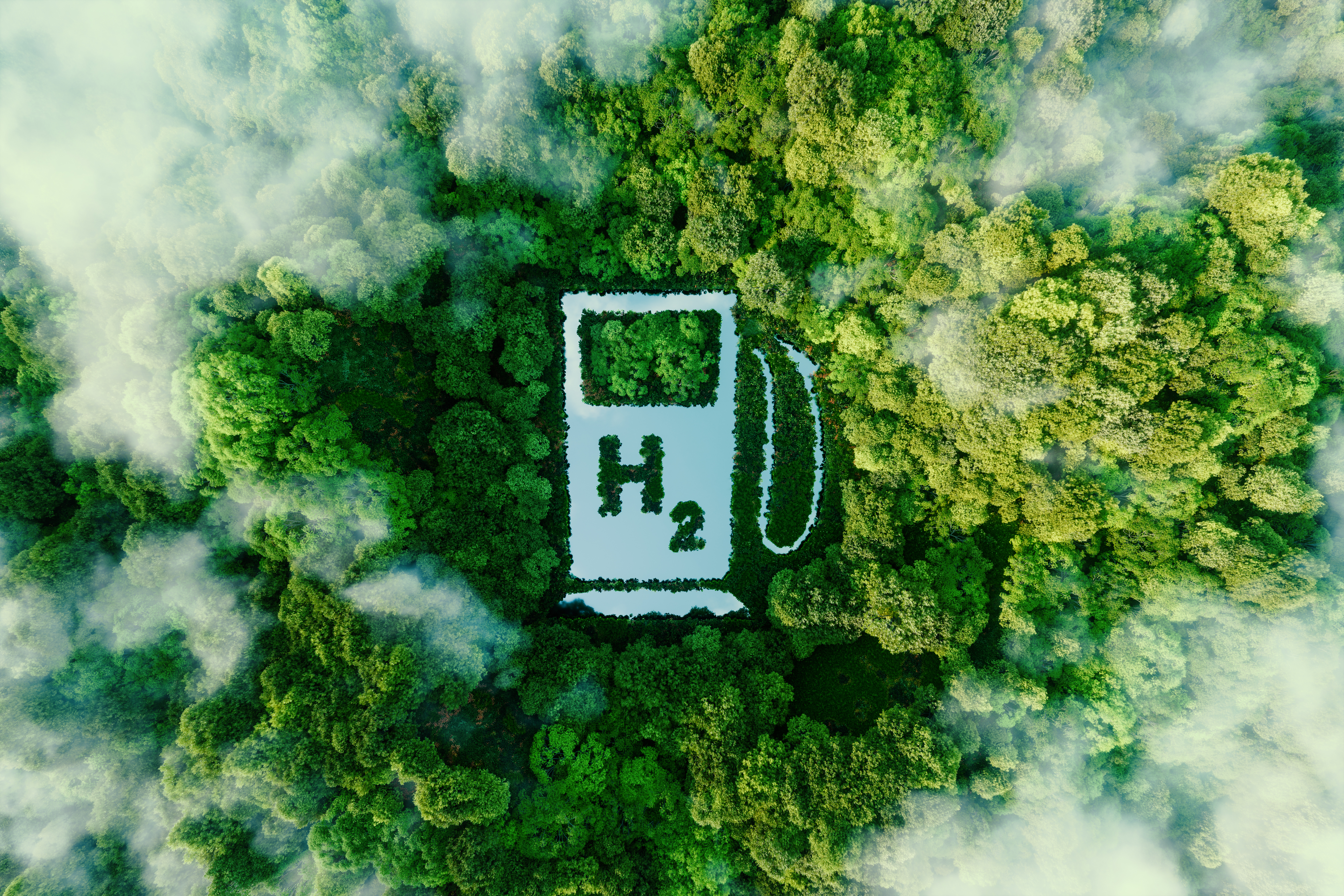Education Center / The 9 Colors and Carbon Impacts of Hydrogen
Blog
Category: Alternative Fuel
The 9 Colors and Carbon Impacts of Hydrogen
For years, hydrogen has been used for industrial applications: refining petroleum, producing fertilizers, processing foods, and treating metals. More recently, it has been recognized as an alternative fuel. Facing looming emission reduction targets, many within the transportation sector have begun to evaluate hydrogen’s future potential for their fleets and assess how feedstock affects its carbon impact. How big of a difference can hydrogen sourcing make on greenhouse gas emissions whether that be grey, blue or green hydrogen? Keep reading to find out.
LEVEL SETTING ON “ZERO-EMISSIONS”
Across the industry, hydrogen is portrayed as being zero-emission rather than a zero-tailpipe emission solution. While it’s true that hydrogen only results in water vapor when used within a vehicle, that’s not telling of the whole story. To properly determine hydrogen’s lifecycle carbon impact, you must factor in those emissions that occur during production. Because hydrogen is an energy carrier, not an energy source, it must be produced from either renewables, water, or fossil fuels. Depending on feedstock used, hydrogen is then assigned a color—and every color, a carbon impact spectrum. Is your supply of hydrogen carbon-intensive, low carbon, carbon-neutral, or our favorite: carbon-negative? Let’s find out.
#1: WHITE HYDROGEN
For many, this phrasing may be new, and rightfully so. White hydrogen is geological, naturally occurring hydrogen that can be found in underground deposits. However, that’s as far as the story goes (for now at least) as researchers and scientists have yet to identify a viable strategy to use hydrogen from these deposits.
#2: BLACK HYDROGEN
Up next we have black hydrogen, produced when black coal, otherwise known as bituminous coal, undergoes gasification. Gasification relies on high temperatures, those exceeding 700°C or 1,292°F, to break down fossil-based or organic carbonic materials—all without combustion. Instead, using a controlled flow of oxygen and/or steam, black coal is broken down into hydrogen (H2), carbon dioxide (CO2), and carbon monoxide (CO). Although, when it comes to separating hydrogen from the other chemical compounds, the resulting CO2 and CO are released into the atmosphere. For this reason, black hydrogen is associated with having a high carbon impact.
#3: BROWN HYDROGEN
The only thing distinguishing brown hydrogen from black is the color of coal used to produce it. As you may have guessed, brown hydrogen results when brown coal, also known as lignite, undergoes gasification. Both carbon dioxide and carbon monoxide are again released into the atmosphere as potent greenhouse gases—another carbon-intensive hydrogen alternative.
#4: GREY HYDROGEN
Moving away from coal, we have natural gas: a common feedstock selection. After natural gas undergoes steam methane reforming (SMR), grey hydrogen is produced. Steam methane reformation accounts for 95% of current hydrogen production around the world. During the reforming process, methane (CH4) that’s sourced from natural gas reacts with steam (H2O)—resulting in hydrogen, carbon monoxide, and small amounts of carbon dioxide.
What differentiates grey hydrogen from other forms that rely on SMR is that there is no carbon capture and sequestration (CCS) involved. This means that the resulting CO2 and CO are released directly into the atmosphere. Yet, grey hydrogen is only considered to have a moderate greenhouse gas (GHG) impact, producing slightly fewer emissions than both black and brown hydrogen.
#5: TURQUOISE HYDROGEN
Turquoise hydrogen is produced from a process called pyrolysis. Pyrolysis occurs when methane (CH4) from natural gas is decomposed at very high temperatures to generate hydrogen (2H2) and solid carbon (C). Unlike prior selections, turquoise hydrogen does not produce carbon dioxide or carbon monoxide, giving it a low-carbon classification. However, this means of producing hydrogen is still in its experimentation phase and has not been proven at scale.
#6: YELLOW HYDROGEN
Moving on, next is yellow hydrogen which uses mixed-origin grid energy as its feedstock. Depending on what is available, it can be supplied by a variety of sources including solar, alternative renewables, and fossil fuels. To produce yellow hydrogen, these sources of grid electricity undergo electrolysis: a process that uses an electric current to split water molecules into hydrogen and oxygen.
The average carbon impact of yellow hydrogen is moderate, though it can fluctuate based on the energy used to make it. When electricity sourced from coal or conventional natural gas is used, the resulting hydrogen’s carbon intensity (CI) score will be higher. Conversely, when electricity from renewable sources is used, the CI score will decrease accordingly.
#7: PINK/PURPLE/RED HYDROGEN
Next, we have hydrogen that’s often referred to by one of three colors: pink, purple, or red. Regardless of what color you use to describe it, this hydrogen is made the same way. Steam is extracted from nuclear power plants and passed through an electrolyzer, producing two outputs: pure hydrogen and oxygen. Since there are no direct carbon emissions that result from this process, the GHG impact of producing pink/purple/red hydrogen is minimal.
#8: BLUE HYDROGEN
And just like that, we’re down to the final two contenders: those that have received the most attention across the industry as of late. When it comes to blue hydrogen, at the most basic level, it goes one step beyond grey, black, and brown hydrogen to lower its carbon impact. Not only does it use natural gas (or coal) in steam methane reformation to produce hydrogen, but also incorporates carbon capture and sequestration (CCS). What does this mean? The resulting carbon dioxide and carbon monoxide that is produced from SMR is captured before it can be released into the atmosphere and then stored underground. This process results in a low-carbon solution, but what many don’t know is that carbon-negative blue hydrogen is possible.
Rather than using conventional, fossil natural gas as a feedstock, producers can turn to renewable natural gas (RNG). RNG captures methane at agricultural facilities, landfills, and wastewater treatment plants that otherwise would have been released into the atmosphere as a potent greenhouse gas. Depending on feedstock used, RNG can have a CI score ranging from -530 up to 80—the lower the score, the better the environmental impact. For hydrogen producers, the best low-carbon scenario comes from dairy-based RNG which features a CI score ranging from -530 to -150. How easy is it to make the switch if you’re already producing blue hydrogen? Simply switch the natural gas you’re using for SMR from fossil-based to RNG.
#9: GREEN HYDROGEN
Last, but not least, we have green hydrogen which is known for its minimal carbon impact. Produced through the electrolysis of water, it leverages electricity solely from renewable sources—whether that be wind, solar, hydropower, or tidal. In California, green hydrogen that’s made using solar- or wind-generated electricity in electrolysis can have a 10.51 CI score according to the California Air Resources Board’s (CARB) hydrogen lookup table. Compared to yellow hydrogen’s 164.46 CI score in California (using average grid electricity), the positive impact of renewables is undeniable.
There are a few key considerations with green hydrogen, one being cost. In 2020, it was two to three times more expensive to produce green hydrogen than blue hydrogen. In fact, the IEA reported that in 2021, the cost of hydrogen made using an electrolyzer was between $3-$8 per kilogram (kg), yet only comprised ~0.03% of all hydrogen produced. Recognizing the positive impact it can have on decarbonizing operations that rely on or are transitioning to hydrogen, the race is on to lower the cost associated with electrolyzers.
FUTURE OUTLOOK ON THE HYDROGEN MARKET
As state and local governments look for new ways to leverage hydrogen’s low carbon potential across sectors and applications, the industry should be hopeful. It’s projected that hydrogen will result in 16% CO2 emission reductions, 36% NOx emission reductions, and account for ~14% of final energy demand in the United States by 2050.
But, as to what color of hydrogen will lead in terms of market share, it’s too soon to tell. However, the time is now to plan how to best integrate hydrogen into your transportation strategy. For help navigating the landscape, scaling adoption of hydrogen, and integrating it into your existing fueling portfolio, reach out!












